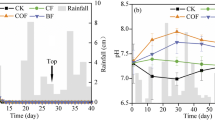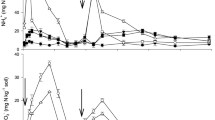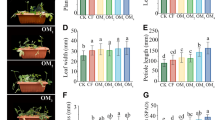Abstract
Nitrogen (N) losses from agricultural soils deteriorate environment, through NH3 depositions, and limit the agricultural productivity. Urea-N loss is considered to be minimized through urea hydrolysis inhibition by using various synthetic and natural soil urease inhibitors. However, the contribution of vegetable plant canopy towards soil urease inhibition is not well documented. In this study, eight vegetable species, viz., Capsicum annum, Capsicum frutescens, Solanum lycopersicum, Cucumis sativus, Allium cepa, Brassica oleracea, Cucurbita pepo, and Solanum melongena, were investigated for soil urease activity (SUA) at three transplanting intervals (15, 30, and 45 days after transplantation (DAT)) and two sampling depths (0–4.5 cm and 4.5–9.0 cm) under PPD (p-phenylenediamine) 1.0%-coated, HQ (hydroquinone) 2.0%-coated, and/or uncoated urea (pure urea) applications during February–May, 2021. The SUA was found to be reduced by 19%, 21%, 18%, 15%, and 30% in soils cultivated with C. annum, C. frutescens, C. sativus, C. pepo, and S. melongena, respectively, at 15 DAT with respect to 30 DAT. Similarly, except C. pepo, all the vegetable canopies significantly reduced SUA at 4.5–9.0 cm in comparison to 0–4.5 cm soil depth. The reduction of SUA, subsequently, reduced NH3 loss by ~ 50%, on an average, under PPD 1.0%-coated urea in comparison to uncoated urea application with fruit yield enhancements in C. annum (238.3 g plant−1) and C. frutescens (45.9 g plant−1). Altogether, the impact of vegetable plant canopies was found significant in reducing SUA at 15 DAT and 4.5–9.0 cm of sampling depth under PPD 1.0%-coated urea application.







Similar content being viewed by others
Data Availability
The data is available as figures, tables and supplementary material in this manuscript. Further queries may be addressed to the corresponding author.
References
Afshar RK, Lin R, Mohammed YA, Chen C (2018) Agronomic effects of urease and nitrification inhibitors on ammonia volatilization and nitrogen utilization in a dryland farming system: field and laboratory investigation. J Clean Prod 172:4130–4139. https://doi.org/10.1016/j.jclepro.2017.01.105
Ahmad I, Cheng Z, Meng H, Liu T, Wang M, Ejaz M, Wasila H (2013) Effect of pepper-garlic intercropping system on soil microbial and bio-chemical properties. Pak J Bot 45(2):695–702
Badri DV, Chaparro JM, Zhang R, Shen Q, Vivanco JM (2013) Application of natural blends of phytochemicals derived from the root exudates of arabidopsis to the soil reveal that phenolic-related compounds predominantly modulate the soil microbiome. J Biol Chem 288(7):4502–4512. https://doi.org/10.1074/jbc.M112.433300
Behera SN, Sharma M, Aneja VP, Balasubramanian R (2013) Ammonia in the atmosphere: a review on emission sources, atmospheric chemistry and deposition on terrestrial bodies. Environ Sci Pollut Res 20:8092–8131. https://doi.org/10.1007/s11356-013-2051-9
Caldwell BA (2005) Enzyme activities as a component of soil biodiversity: a review. Pedobiologia 49(6):637–644. https://doi.org/10.1016/j.pedobi.2005.06.003
Callahan BP, Yuan Y, Wolfenden R (2005) The burden borne by urease. J Am Chem Soc 127:10828–10829. https://doi.org/10.1021/ja0525399
Cameron KC, Di HJ, Moir JL (2013) Nitrogen losses from the soil/plant system: a review. Ann Appl Biol 162:145–173. https://doi.org/10.1111/aab.12014
Canfield DE, Glazer AN, Falkowski PG (2010) The evolution and future of earth’s nitrogen cycle. Science 330:192–196. https://doi.org/10.1126/science.1186120
Chen KE, Chen HY, Tseng CS, Tsay YF (2020) Improving nitrogen use efficiency by manipulating nitrate remobilization in plants. Nat Plants 6:1126–1135. https://doi.org/10.1038/s41477-020-00758-0
Denmead OT, Freney JR, Dunin FX (2008) Gas exchange between plant canopies and the atmosphere: case-studies for ammonia. Atmos Environ 42:3394–3406. https://doi.org/10.1016/j.atmosenv.2007.01.038
Falik O, Mordoch Y, Ben-Natan D, Vanunu M, Goldstein O, Novoplansky A (2012) Plant responsiveness to root-root communication of stress cues. Ann Bot 110:271–280. https://doi.org/10.1093/aob/mcs045
Falik O, Hoffmann I, Novoplansky A (2014) Say it with flowers: flowering acceleration by root communication. Plant Signal Behav 9:4. https://doi.org/10.4161/psb.28258
Haichar FZ, Santaella C, Heulin T, Achouak W (2014) Root exudates mediated interactions belowground. Soil Biol Biochem 77:69–80. https://doi.org/10.1016/j.soilbio.2014.06.017
Hristov AN, Bannink A, Crompton LA et al (2019) Invited review: Nitrogen in ruminant nutrition: a review of measurement techniques. J Dairy Sci 102:5811–5852. https://doi.org/10.3168/jds.2018-15829
Juan YH, Chen ZH, Chen LJ, Qiu WW, Zhang LL, Zhang YL (2014) Kinetics of soil urease in four agricultural soils affected by urease inhibitor PPD at contrasting moisture regimes. Commun Soil Sci Plant Anal 45(17):2268–2276. https://doi.org/10.1080/00103624.2014.932369
Kandeler E, Gerber H (1988) Short-term assay of soil urease activity using colorimetric determination of ammonium. Biol Fertil Soils 6:68–72. https://doi.org/10.1007/BF00257924
Klimczyk M, Siczek A, Schimmelpfennig L (2021) Improving the efficiency of urea-based fertilization leading to reduction in ammonia emission. Sci Total Environ 771:145483. https://doi.org/10.1016/j.scitotenv.2021.145483
Krajewska B (2009) Ureases I. Functional, catalytic and kinetic properties: a review. J Mol Catal B Enzym 59:9–21. https://doi.org/10.1016/j.molcatb.2009.01.003
Krajewska B, Zaborska W (2007) Jack bean urease: the effect of active-site binding inhibitors on the reactivity of enzyme thiol groups. Bioorg Chem 35:355–365. https://doi.org/10.1016/j.bioorg.2007.02.002
Lassaletta L, Billen G, Grizzetti B, Anglade J, Garnier J (2014) 50 year trends in nitrogen use efficiency of world cropping systems: the relationship between yield and nitrogen input to cropland. Environ Res Lett 9:105011. https://doi.org/10.1088/1748-9326/9/10/105011
Li Q, Cui X, Liu X, Roelcke M, Pasda G, Zerulla W, Wissemeier AH, Chen X, Goulding K, Zhang F (2017) A new urease-inhibiting formulation decreases ammonia volatilization and improves maize nitrogen utilization in North China Plain. Sci Rep 7:43853. https://doi.org/10.1038/srep43853
Liu Z, Song X, Jiang L, Lin H, Xu Y, Gao X, Zhang F, Tan D, Wang M, Shi J, Shen Y (2012) Strategies for managing soil nitrogen to prevent nitrate-N leaching in intensive agriculture system. In: Hernandez-Soriano Maria C (ed) Soil health and land use management. IntechOpen, Leuven, pp 133–153. https://doi.org/10.5772/29419
Mcallister CH, Beatty PH, Good AG (2012) Engineering nitrogen use efficient crop plants: the current status. Plant Biotechnol J 10:1011–1025. https://doi.org/10.1111/j.1467-7652.2012.00700.x
Meng X, Li Y, Yao H, Wang J, Dai F, Wu Y, Chapman S (2020) Nitrification and urease inhibitors improve rice nitrogen uptake and prevent denitrification in alkaline paddy soil. Appl Soil Ecol 154:103665. https://doi.org/10.1016/j.apsoil.2020.103665
Naz MY, Sulaiman SA (2014) Testing of starch-based carbohydrate polymer coatings for enhanced urea performance. J Coat Technol Res 11:747–756. https://doi.org/10.1007/s11998-014-9590-y
Nelson DW (1983) Determination of ammonium in kc1 extracts of soils by the salicylate method. Commun Soil Sci Plant Anal 14(11):1051–1062. https://doi.org/10.1080/00103628309367431
Pakistan Economic Survey 2019–2020. Economic Adviser’s Wing, Finance Division, Government of Pakistan, Islamabad, Pakistan. https://www.finance.gov.pk/survey_1920.html. Accessed 13 Jan 2024
Pan B, Lam SK, Mosier A, Luo Y, Chen D (2016) Ammonia volatilization from synthetic fertilizers and its mitigation strategies: a global synthesis. Agric Ecosyst Environ 232:283–289. https://doi.org/10.1016/j.agee.2016.08.019
Schjoerring JK, Mattsson M (2001) Quantification of ammonia exchange between agricultural cropland and the atmosphere: measurements over two complete growth cycles of oilseed rape, wheat, barley and pea. Plant Soil 228:105–115. https://doi.org/10.1023/A:1004851001342
Semchenko M, Saar S, Lepik A (2014) Plant root exudates mediate neighbour recognition and trigger complex behavioural changes. New Phytol 204:631–637. https://doi.org/10.1111/nph.12930
Skorupka M, Nosalewicz A (2021) Ammonia volatilization from fertilizer urea—a new challenge for agriculture and industry in view of growing global demand for food and energy crops. Agriculture 11:822. https://doi.org/10.3390/agriculture11090822
Suherman, Anggoro DD (2011) Producing slow release urea by coating with starch/acrylic acid in fluid bed spraying. Int J Eng Technol 11:77–80
Watson CJ, Akhonzada NA, Hamilton JTG, Matthews DI (2008) Rate and mode of application of the urease inhibitor N-(n-butyl) thiophosphoric triamide on ammonia volatilization from surface-applied urea. Soil Use Manag 24:246–253. https://doi.org/10.1111/j.1475-2743.2008.00157.x
Xu X, Zhou L, Van CO, Wang Z (2000) Fate of urea-15 N in a soil-wheat system as influenced by urease inhibitor hydroquinone and nitrification inhibitor dicyandiamide. Plant Soil 220:261–270. https://doi.org/10.1023/A:1004715827085
Yang J, Jiao Y, Yang WZ, Gu P, Bai SG, Liu LJ (2018) Review of methods for determination of ammonia volatilization in farmland. In IOP Conf Series: Earth Environ Sci 113:012022. https://doi.org/10.1088/1755-1315/113/1/012022
Ye JY, Tian WH, Jin CW (2022) Nitrogen in plants: from nutrition to the modulation of abiotic stress adaptation. Stress Biol 2:4. https://doi.org/10.1007/s44154-021-00030-1
Zhang L, Chen Y, Zhao Y, Henze DK, Zhu L, Song Y, Paulot F, Liu X, Pan Y, Huang B (2018) Agricultural ammonia emissions in China: reconciling bottom-up and top-down estimates. Atmos Chem Phys 18:339–355. https://doi.org/10.5194/acp-2017-749
Zhang X, Gu B, van Grinsven H, Lam SK, Liang X, Bai M, Chen D (2020) Societal benefits of halving agricultural ammonia emissions in China far exceed the abatement costs. Nat Commun 11:4357. https://doi.org/10.1038/s41467-020-18196-z
Zhang P, Bonte D, De Deyn GB, Vandegehuchte ML (2021) Leachates from plants recently infected by root-feeding nematodes cause increased biomass allocation to roots in neighbouring plants. Sci Rep 11:2347. https://doi.org/10.1038/s41598-021-82022-9
Acknowledgements
The technical staff of the laboratories of Faculty of Agricultural Sciences, University of the Punjab, Lahore, is acknowledged for their support and facilitation of experiments.
Funding
The research was supported by the Office of Research Innovation and Commercialization (ORIC), Lahore College for Women University (LCWU), Lahore, Pakistan.
Author information
Authors and Affiliations
Contributions
SS and RM designed the research. SS performed the research. FN, RM, and AF analyzed the data. SS and FN wrote the manuscript. FN, SA, and MSH revised the manuscript. All authors approved the final manuscript.
Corresponding authors
Ethics declarations
Conflict of Interest
The authors declare no competing interests.
Additional information
Publisher's Note
Springer Nature remains neutral with regard to jurisdictional claims in published maps and institutional affiliations.
Supplementary Information
Below is the link to the electronic supplementary material.
Rights and permissions
Springer Nature or its licensor (e.g. a society or other partner) holds exclusive rights to this article under a publishing agreement with the author(s) or other rightsholder(s); author self-archiving of the accepted manuscript version of this article is solely governed by the terms of such publishing agreement and applicable law.
About this article
Cite this article
Shakeel, S., Mahmood, R., Fatima, A. et al. Vegetable Plant Canopy Inhibits Soil Urease Activity and Reduces NH3 Losses Under p-Phenylenediamine (PPD)-Coated Urea Application. J Soil Sci Plant Nutr 24, 1225–1234 (2024). https://doi.org/10.1007/s42729-024-01624-0
Received:
Accepted:
Published:
Issue Date:
DOI: https://doi.org/10.1007/s42729-024-01624-0




